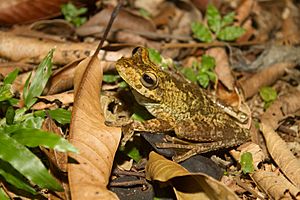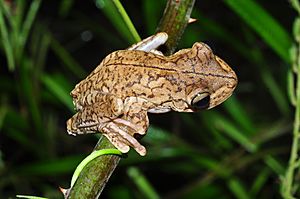Rosenberg's tree frog facts for kids
Quick facts for kids Rosenberg's tree frog |
|
|---|---|
 |
|
| Conservation status | |
| Scientific classification | |
| Synonyms | |
|
Rosenberg's treefrog, also known as Rosenberg's gladiator frog, is a type of frog. It belongs to the tree frog family, Hylidae. You can find these frogs in countries like Costa Rica, Panama, Colombia, Trinidad and Tobago, and northwestern Ecuador. Its scientific name, Hypsiboas rosenbergi, honors Mr. W. F. H. Rosenberg, who first collected these frogs. The name "gladiator frog" comes from how aggressive the male frogs can be.
Contents
- What Does the Gladiator Frog Look Like?
- Where Do Gladiator Frogs Live?
- Protecting the Gladiator Frog
- What Do Gladiator Frogs Eat?
- Reproduction and Life Cycle
- Mating Rituals
- How Gladiator Frogs Care for Their Young
- Social Behavior of Gladiator Frogs
- Who Eats the Gladiator Frog?
- Images for kids
- See also
What Does the Gladiator Frog Look Like?
The size of Rosenberg's treefrog can be different depending on where it lives. Frogs from Costa Rica are usually smaller than those from Panama. In Panama, male frogs are about 83 millimeters (3.3 inches) long. Females are a bit longer, around 86 millimeters (3.4 inches), and they also tend to be heavier.
These frogs have partly webbed fingers and fully webbed toes. They also have large sticky pads on their fingers and toes. Their skin feels bumpy with small warts. It can be yellowish, grayish, or reddish, often with brown or black swirly patterns or spots. They also have dark, worm-like marks on their backs and legs. Their undersides are gray-white, with a darker area near the throat.
Male frogs usually have darker throats than females. This might be because hormones make them call more often. Females, however, often have more yellow on their backs. The skin on the female's belly, near her groin, is almost clear. This allows you to easily see her black eggs inside. Rosenberg's treefrog has a pale yellow lower jaw with similar black worm-like marks. Their eyes have a bronze or golden color with black around them. During the day, most of their colors fade to light gray or tan, and their patterns become less visible.
Male Rosenberg's treefrogs have special pointed spines on their hands. These are called prepollical spines and are shaped like scythes. They use these spines when they fight, which is why they are called "gladiator frogs." Females also have these spines, but they are very small. Only males can move these spines and pull back a fleshy cover to show the sharp parts for fighting.
Where Do Gladiator Frogs Live?
Rosenberg's treefrog lives in both old and new forests. They can also be found in areas changed by humans, like small groups of trees in fields. This species has been seen from Panama all the way to Costa Rica. It's not fully known if they live continuously across this whole area. Their range might stretch from central Panama to western Ecuador.
These frogs often live in the same places as other frog species, like H. boans and sometimes H. pugnax. They are found together in places like the Rio Sinu headwaters and the Parque Nacional Natural de Katios in Colombia.
Protecting the Gladiator Frog
Rosenberg's treefrog is considered an adaptable species. This means it can adjust to different environments. It is not currently facing any major threats. These frogs have been found in protected areas like Piedras Blancas National Park and Corcovado National Park in Costa Rica. These parks help protect their homes from being destroyed.
What Do Gladiator Frogs Eat?
Rosenberg's treefrogs eat small insects and other arthropods that they find close to the ground. The number of insects they eat is highest during the wet season.
Adult frogs do not grow during their breeding season. This is because they use a lot of energy for other things, not because there isn't enough food. Females use energy to grow eggs. Males use energy to attract mates, build nests, and protect their territory. All these activities take time away from hunting for food. During the breeding season, females tend to hunt for food high up in the forest trees. Males, however, look for food closer to the ground.
Reproduction and Life Cycle
Female Rosenberg's treefrogs lay eggs about every 25 days. Each time, they lay around two thousand eggs. These eggs have a dark top and a yellow-white bottom, surrounded by two clear layers. They are laid one by one on the water's surface, spreading out to form a single layer.
About 40 hours after the eggs are fertilized, the baby frogs (offspring) start to form tail buds. These tails grow quickly for about 150 hours. The offspring also begin to hatch from the eggs around 40 hours after fertilization. They start swimming motions around 85 hours and can actively swim by 140 hours. The tadpoles have large, feathery gills.
Rosenberg's treefrog tadpoles change into froglets (metamorphosis) when they are about 21 millimeters long. This happens about 40 days after fertilization. These young froglets have many small dark spots. Their fingers and toes have much less webbing compared to adult frogs. After changing, the froglets leave the water. These frogs can become adults and start reproducing themselves in just one year.
The reproduction of H. rosenbergi is affected by both social and environmental factors. Female frogs are influenced by how many other frogs are calling nearby. Male frogs are influenced by rainfall on the same day (heavy rain means less activity) and how many frogs were calling the day before.
Mating Rituals
The breeding season for Rosenberg's treefrog is from March to May. Mating usually happens around a nest built by the male frog. Once a nest is built, males call from inside it at night. They usually call for only a few nights over a week.
Males make a special "advertisement call" to attract females. This call sounds like a "tonk-tonk-tonk" with three notes. The way they call can change based on other males nearby. If there are more competing males or more attractive males close by, the male frogs will call more often. Males living close to each other tend to have similar calling rates, meaning they adjust to each other. These calls are usually made in small groups.
When a female is ready to mate, she responds to the male's call. She approaches and enters his nest from behind him. The male then stops calling or switches to a "courtship call" that lasts longer. The female swims around the nest, checking it out. In Panama, some females were seen fixing up the nest, but this was not seen in Costa Rica.
If the female decides to mate, she will gently rub the male with her chest by swimming and patting him with her hands. Then, the male will climb onto the female's back to start mating (amplexus). The male holds onto the female's neck. The female is completely underwater except for where she releases eggs. Mating lasts about 10 minutes. After this, the eggs spread out on the water's surface in a single layer. It's rare for males to force a female to mate. Sometimes, another male will attack a mating pair to separate them. The attacking male might then mate with the female.
Overall, only a few calling males successfully mate with a female. The best way to tell if a male will mate successfully is how many nights he has been calling.
How Gladiator Frogs Care for Their Young
Parental care in this species involves guarding the eggs and building nests for them.
These nests are dips in the ground filled with water. Their shape changes depending on where they are built. In Panama, where the frogs breed along a river, all males build their own nests. However, in Costa Rica, in a small swampy cattle field, only some males build nests. Many males use small puddles or even cow footprints as nests. They only build nests by pushing plants away if no other watery spots are available. This means they build nests only when needed. Building a nest takes a lot of time and energy (one night for a male, during which he cannot call for a mate). So, these frogs will use existing water spots or reuse old nests to save time and energy. Males usually don't share nests, but abandoned nests will be reused.
For guarding the eggs, males sit near or right above the freshly laid eggs. They stay quiet, only making territorial calls sometimes. Males likely guard the eggs from other males who could disturb the water surface, causing the eggs to sink and die. Males guard the eggs for one or two nights, but never longer. This is because they need to go back to calling for mates. If other males are nearby, the guarding male will leave his eggs but quickly return to his guarding spot when he hears their calls. Interestingly, egg guarding has only been seen in the Panamanian population of H. rosenbergi, not in the Costa Rican one.
Social Behavior of Gladiator Frogs
Male Rosenberg's treefrogs are either "intruders" or "residents." Residents are males that have a nest to call from. Intruder males rarely take over a resident's nest. Intruders move around a lot without making calls to attract mates. However, they do make calls to mark their territory or when they meet other frogs.
The English name "gladiator frog" suggests that males are aggressive. However, male-on-male fighting has only been seen in the Panamanian population, not in Costa Rica. This is probably because there are many nest sites and fewer active males in Costa Rica.
When fighting is observed, it takes three forms:
- Undirected aggression: This includes territorial calls and sounds made when meeting another frog, but not aimed at a specific opponent.
- Nonviolent aggression: Males sense each other but don't touch. They might charge or chase each other.
- Violent aggression: Males physically fight, wrestling or pushing opponents away, in or near a nest. This type of fighting also involves growling and hissing. They use their sharp prepollical spines. Violent fights can cause serious injuries or even death. This is the most costly type of aggression because the noise and exposure from the fight can attract predators. It also uses a lot of energy, often forcing the fighting males to leave the breeding area or making them unable to call for a mate.
Who Eats the Gladiator Frog?
Predators of Rosenberg's treefrog include snakes, like the banded cat-eyed snake (Leptodeira annulata). Other frogs, such as the smoky jungle frog (Leptodactylus pentadactylus), also eat them. It's possible that mammals and crocodiles might also prey on them. Most predation happens at night.
Images for kids
See also
 In Spanish: Hypsiboas rosenbergi para niños
In Spanish: Hypsiboas rosenbergi para niños




